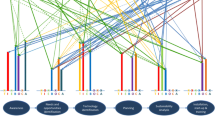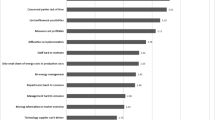Abstract
The industrial sector is one of the main energy consuming sectors in Thailand and accounted for 36.7% of total energy consumption in 2005. The trend of rising energy prices and tougher competition increases the demand to improve energy efficiency in Thai industry. However, the existence of various barriers often hinders the realization of even some cost-effective energy efficiency measures. In an attempt to investigate key barriers to and drivers for energy efficiency improvement in Thai industry, this study found that the most important barrier expressed by both the textile and cement industries studied as well as experts interviewed is that the management is concerned about production and other matters rather than energy efficiency. Reducing product cost by reducing energy cost is found to be the main driver for energy efficiency investment. Using a conceptual industrial energy efficiency policy framework this study shows how various energy efficiency policies can affect the process of decision-making for and investment in energy efficiency in industry.




Similar content being viewed by others
Notes
A Likert scale is a type of psychometric response scale often used in questionnaires, and is one of the most widely used scales in survey research. When responding to a Likert questionnaire item, respondents specify their level of agreement to a statement.
Energy elasticity = annual growth of energy consumption/annual growth of GDP
GDP at 1988 prices
Divisia decomposition technique is one technique that is used to decompose the changes in energy intensity or GHG emissions into several defined factors such as structural change of the industry, energy efficiency improvement, etc. (Ang and Zhang 2000)
They have defined energy intensity as energy used per unit of GDP.
It should be noted that while in our questionnaire we provided textile and cement plants to score the options under each main question, for interviewees we just ask the main questions and let them answer based on their experience in Thailand.
Department of Alternative Energy Development and Efficiency
References
Ang, B. W., & Zhang, F. Q. (2000). A survey of index decomposition analysis in energy and environmental studies. Energy, 25, 1149–1176.
Bhattacharyya, S. C., & Ussanarassamee, A. (2005). Changes in energy intensities of Thai industry between 1981 and 2000: A decomposition analysis. Energy Policy, 33, 995–1002.
Brown, M. A. (2001). Market failures and barriers as a basis for clean energy policies. Energy Policy, 29(14), 1197–1207.
Chirarattananon, S. (2006). Review of energy conservation policies in Thailand. Report prepared at the Joint Graduate School of Energy and Environment.
de Groot, H., Verhoef, E., & Nijkamp, P. (2001). Energy saving by firms: Decision-making, barriers and policies. Energy Economics, 23(6), 717–740.
du Pont, P. T. (1998). Energy policy and consumer reality: The role of energy in the purchase of household appliances in the US and Thailand. Doctoral thesis, University of Delaware, USA. Retrieved on October 30, 2008 from http://www.clasponline.org/clasp.online.resource.php?disdoc = 102.
DeCanio, S. J. (1998). The efficiency paradox: Bureaucratic and organizational barriers to profitable energy-saving investments. Energy Policy, 26(5), 441–454.
DEDE (Department of Alternative Energy Development and Efficiency) (2002). Energy efficiency in Thai industry, Thai-German energy efficiency promotion report.
DEDE (Department of Alternative Energy Development and Efficiency) (2007). Thailand Energy Situation (volumes1983–2007), available at DEDE’s library and recent volumes retrieved on May 9, 2009 from http://www.dede.go.th/dede/index.php?id=152.
DEDE (Department of Alternative Energy Development and Efficiency) (2008). Revolving fund for energy conservation. Retrieved on October 30, 2008 from http://www2.dede.go.th/RFProgram/rf_en/detail/index.php.
European ESD (Energy End-Use Efficiency and Energy Service Directive) (2006). Directive 2006/32/EC of the European parliament and of the council. Official Journal of the European Union. Retrieved on May 11, 2009 from: http://eur-lex.europa.eu/LexUriServ/LexUriServ.do?uri=OJ:L:2006:114:0064:0085:EN:PDF.
Farla, J., & Blok, K. (1998). Evaluation of the Energy Bonus in the Netherlands in the 1980s. Industrial Energy Efficiency Policies: Understanding Success and Failure: Proceedings of a Workshop Organized by the International Network for Energy Demand Analysis in the Industrial Sector. Utrecht, The Netherlands, June 11–12, 1998. Retrieved on January 12, 2009 from: http://industrial-energy.lbl.gov/node/81.
Galitsky, C., Price, L., & Worrell, E. (2004). Energy Efficiency Programs and Policies in the Industrial Sector in Industrialized Countries. Report prepared by Ernest Orlando Lawrence Berkeley National Laboratory. LBNL-54068. Retrieved on October 30, 2008 from http://industrial-energy.lbl.gov/node/132.
Golove, W. H., & Eto, J. H. (1996). Market barriers to energy efficiency: A critical reappraisal of the rationale for public policies to promote energy efficiency. Lawrence Berkeley National Laboratory, LBL-38059. Retrieved on October 30, 2008 from http://eetd.lbl.gov/ea/emp/reports/38059.pdf.
Hamel, J., Dufour, S., & Fortin, D. (1993). Case study methods. CA: Sage.
IPCC (Intergovernmental Panel on Climate Change) (2001). Contribution of Working Group III to the Third Assessment Report of the Intergovernmental Panel on Climate Change. Chapter 5. Barriers, Opportunities, and Market Potential of Technologies and Practices. Retrieved on October 30, 2008 from http://www.grida.no/publications/other/ipcc_tar/?src=/climate/ipcc_tar/wg3/index.htm.
Jaffe, A. B., & Stavins, R. N. (1994). The energy-efficiency gap: What does it mean? Energy Policy, 22(10), 804–810.
Kumar, S., Visvanathan, C., Peng, S., Rudramoorthy, R., Herrera, A. B., Senanayake, G., et al. (2005). Barriers to promoting energy efficient and environmentally friendly technologies to SMIs in Asia. Bangkok: Asian Institute of Technology.
NESDB (National Economic and Social Development Board) (2008). National Income of Thailand, 1993–2007 series. Retrieved on May 9, 2009 from http://www.nesdb.go.th/Default.aspx?tabid=94.
Patton, M. Q. (2002). Qualitative research and evaluation methods (3rd ed.). London: Sage.
Price, L. (2005). Voluntary Agreements for Energy Efficiency or GHG Emissions Reduction in Industry: An Assessment of Programs around the World. Report prepared by Ernest Orlando Lawrence Berkeley National Laboratory. LBNL-58138. Retrieved on October 30, 2008 from http://industrial-energy.lbl.gov/node/107.
Price, L., & Worrell, E. (2000). International Industrial Sector Energy Efficiency Policies. Report prepared by Ernest Orlando Lawrence Berkeley National Laboratory. LBNL 46274. Retrieved on October 30, 2008 from http://ies.lbl.gov/node/162.
Price, L., Galitsky, C., Sinton, J. Worrell, E., & Graus, W. (2005). Tax and Fiscal Policies for Promotion of Industrial Energy Efficiency: A Survey of International Experience. Report prepared by Ernest Orlando Lawrence Berkeley National Laboratory. LBNL-58128. Retrieved on October 30, 2008 from http://industrial-energy.lbl.gov/node/129.
Rohdin, P., & Thollander, P. (2006). Barriers to and driving forces for energy efficiency in the non-energy intensive manufacturing industry in Sweden. Energy, 31(12), 1836–1844.
Rohdin, P., Thollander, P., & Solding, P. (2007). Barriers to and drivers for energy efficiency in the Swedish foundry industry. Energy Policy, 35(1), 672–677.
Sandberg, P., & Söderström, M. (2003). Industrial energy efficiency: The need for investment decision support from a manager perspective. Energy Policy, 31, 1623–1634.
Schleich, J., & Gruber, E. (2008). Beyond case studies: Barriers to energy efficiency in commerce and the services sector. Energy Economics, 30, 449–464.
Sola, A. V. H., & Xavier, A. A. P. (2007). Organizational human factors as barriers to energy efficiency in electrical motors systems in industry. Energy Policy, 35, 5784–5794.
Thai Energy (2008a). Energy policy project—Tax incentives. Retrieved on October 30, 2008 from http://www.thaienergy.org/index.php?option=com_content&task=view&id=66&Itemid=88.
Thai Energy (2008b). Energy policy project—Rebates for installation of energy-saving measures. Retrieved on October 30, 2008 from http://www.thaienergy.org/index.php?option=com_content&task=view&id=69&Itemid=88.
Thiruchelvam, M., Kumar, S., & Visvanathan, C. (2003). Policy options to promote energy efficient and environmentally sound technologies in small- and medium-scale industries. Energy Policy, 31, 977–987.
Thollander, P., & Ottosson, M. (2008). An energy efficient Swedish pulp and paper industry—Exploring barriers to and driving forces for cost-effective energy efficiency investments. Energy Efficiency, 1, 21–34.
Tonn, B., & Martin, M. (2000). Industrial energy efficiency decision making. Energy Policy, 28, 831–843.
UNEP (United Nations Environment Programme) (2006a). Improving energy efficiency in industry in Asia—A policy review. Retrieved on October 30, 2008 from http://www.energyefficiencyasia.org/brochure_pub.html.
UNEP (United Nations Environment Programme) (2006b). Barriers to energy efficiency in industry in Asia—Review and policy guidance. Retrieved on October 30, 2008 from http://www.energyefficiencyasia.org/brochure_pub.html.
Ussanarassamee, A., & Bhattacharyya, S. C. (2005). Changes in energy demand in Thai industry between 1981 and 2000. Energy, 30, 1845–1857.
Wang, G., Wang, Y., & Zhao, T. (2008). Analysis of interactions among the barriers to energy saving in China. Energy Policy, 36, 1879–1889.
Zilahy, G. (2004). Organizational factors determining the implementation of cleaner production measures in the corporate sector. Journal of Cleaner Production, 12, 311–319.
Acknowledgement
Authors are grateful to the cement and textile companies who cooperated in this study and answered our questionnaire. We also would like to express our appreciation to all the experts who spent their valuable time and participated in our interview. Finally, we would like to thank Assoc. Prof. Dr. Apichit Therdyothin and Prof. Dr. Surapong Chirarattananon for their valuable input for this study.
Author information
Authors and Affiliations
Corresponding author
Rights and permissions
About this article
Cite this article
Hasanbeigi, A., Menke, C. & du Pont, P. Barriers to energy efficiency improvement and decision-making behavior in Thai industry. Energy Efficiency 3, 33–52 (2010). https://doi.org/10.1007/s12053-009-9056-8
Received:
Accepted:
Published:
Issue Date:
DOI: https://doi.org/10.1007/s12053-009-9056-8




